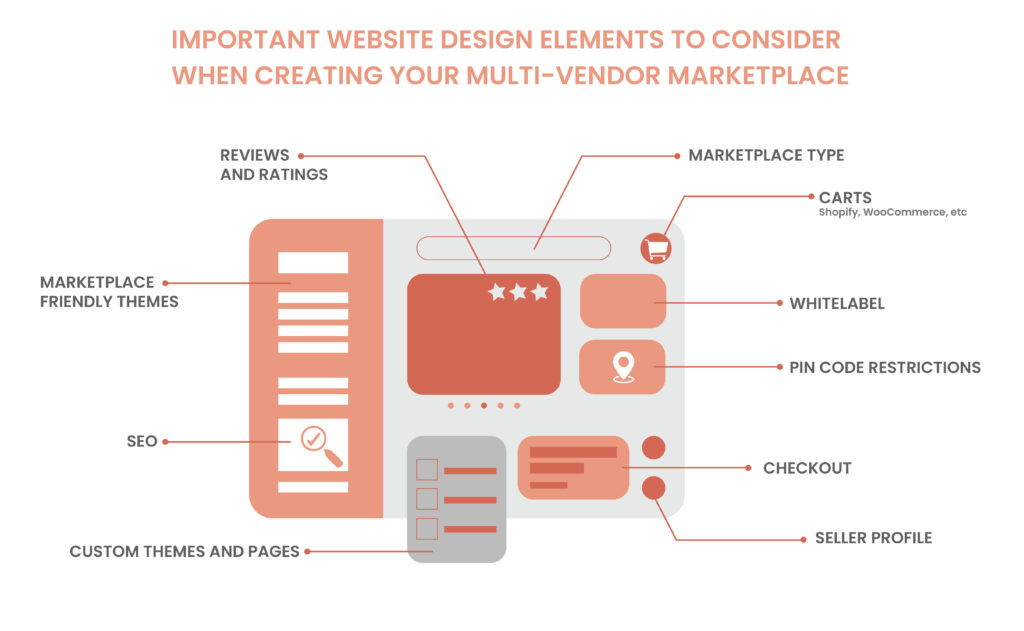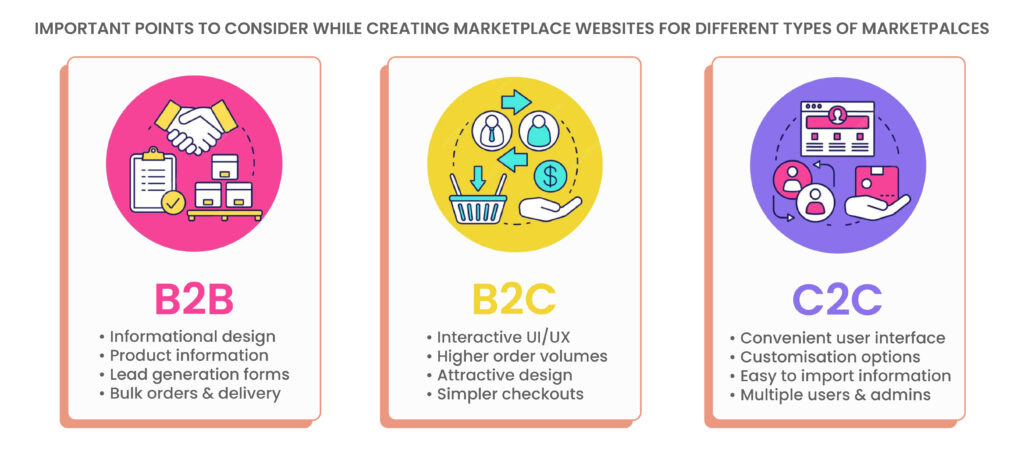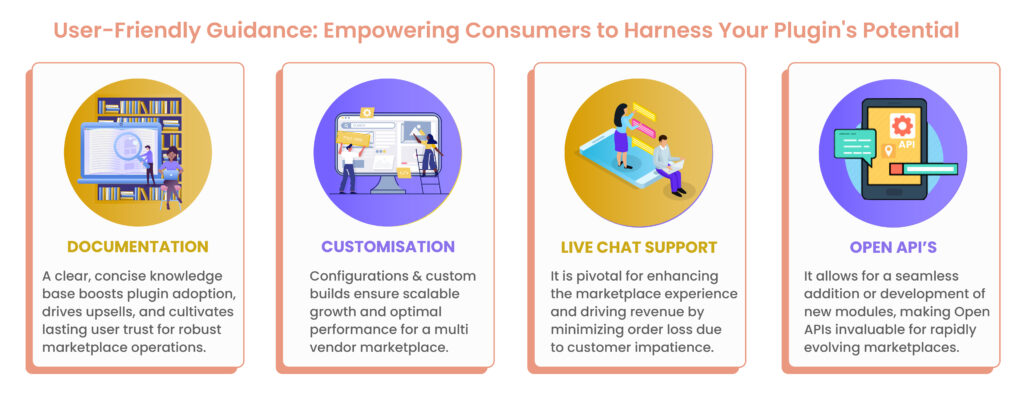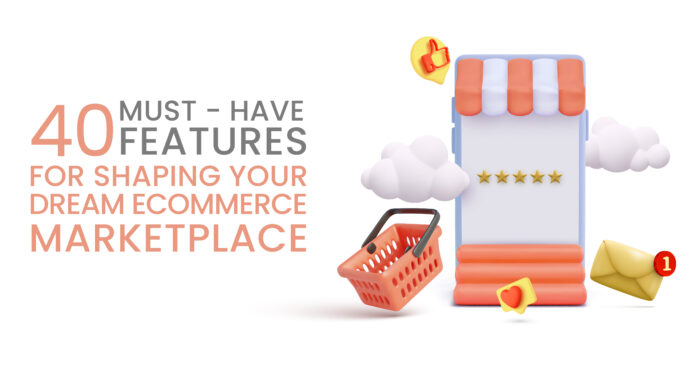Online marketplaces have become a common practice for D2C brands to grow their businesses and establish a central touchpoint for their customers. As e-commerce has grown and become more accessible, the technology associated with running an online marketplace has also grown substantially. Online marketplaces today are equipped to ensure the highest standards of customer experience while making sure that all operations on the backend are running smoothly.
Shipturtle brings you a guide on the must-have features for your marketplace so that you and your organization don’t leave a stone unturned to satisfy your customers. This guide has been divided into seven important aspects for creating a multi-vendor marketplace:
- Website Design
- Vendor Management
- Payments
- Order Management
- Security
- Compatible Apps
- Support


Choosing the correct website design to appeal to your consumers
To build a marketplace that appeals to customers and ensures timely and efficient delivery, the below-mentioned features are a must-have. The features have been curated from the perspective of website design and are a necessity in making sure that your online marketplace has all the right things in all the right places.


Carts
Carts like WooCommerce and Shopify have built many marketplaces over the years and are experts in providing the right technology for the growth of your online store. Custom solutions often require a high degree of expertise and can often prove to be expensive. Carts like Shopify and WooCommerce are stable and have a large developer base, which makes them cost-effective while ensuring the best practices for any marketplace platform are followed.
Marketplace-Friendly Theme
Every D2C brand has a different requirement and hence requires a custom theme to suit the marketplace model as well as the volume of orders on the platform. Choosing the correct layout and theme can significantly increase consumer loyalty. Custom themes also help the online marketplace focus on products, which form the core offering of the brand.
We would like to emphasize the fact that different brands and marketplaces have different theme preferences. A D2C brand that directly interacts with the consumer will have a greater focus on the user experience, where ease of checkout, site navigation, and convenience play a major role. Marketplaces would have a product-focused theme that not only highlights the products that are there but also enables the user to browse through various aspects of the products.
Custom fields and pages
Every online marketplace has a unique marketplace model, order, and shipping management flow. To accommodate the requirements of the website, the design should accommodate requirements around these crucial modules. A multi-seller marketplace would need a dedicated page for onboarding sellers onto the platform, which is not only easy but also efficient and minimizes time to market.
Checkout
A fast, safe, and secure checkout can be the difference between online marketplaces that are superior compared to others. A single-click checkout can revolutionize how e-commerce brands interact with their audience.
Pin Code Restriction
A single-click checkout can be achieved if consumer queries before the checkout are answered via website design integrations. Awareness of whether a product is deliverable in a certain location beforehand can lead to a massive decrease in the number of dropouts at the checkout-initiated event on a website.
A multi-vendor website is extremely tedious to operate since it involves a large volume of vendors who are selling via your online marketplace or website. Each seller can’t deliver to each location. Managing customer expectations by informing them whether delivery is possible in their area can bring convenience to the user’s experience on the website.
Hyperlocal marketplaces often have delivery restrictions for certain pin codes, and making sure users know if delivery is possible within their area can save time and enhance the experience. This is especially useful since hyperlocal marketplaces have really short delivery spans, and experience is placed at the highest pedestal when it comes to them.
Reviews and Ratings
Consumer trust and loyalty are very hard to attain and maintain. To make sure that users trust the brand more with each visit, the website design needs to have a system to manage reviews and ratings. This will not only help the brand understand how they can improve their products but also give the users a reason to buy from the website.
Whitelabel
Reinforcing a brand and its identity can increase top-of-mind recall in the minds of consumers and vendors. White-labeling helps brands interact with their audience through visual elements associated with the brand.
White-labeling is often considered extremely important from the perspective of establishing trust with both vendors and consumers. It’s important to have your brand identity embedded in every communication and touchpoint so that your stakeholders feel that they are interacting with a legitimate organization.
Marketplace Type


Every marketplace website is based on a particular marketplace model. Whether B2B, B2C, or C2C, the website design needs to accommodate the requirements of these marketplace models. A B2B website design would be focused on providing product information most effectively, with a focus on lead generation. A B2C brand will focus on sales, thereby elevating the consumer experience in each aspect of the website. A C2C model will focus on connecting the buyer and seller most effectively and conveniently.
B2C marketplaces have hundreds of products and often have high order volumes. The marketplace type affects the structure of the website itself along with other aspects, which include order management, shipping, and returns. B2C websites would often focus their UI/UX on generating higher value and volume of sales.
C2C marketplaces often act as mediators between two consumers and are focused on making interaction with the website easier. The entire process of making consumers list their products, connect with buyers, and make sales via online and offline mechanisms would be considered while building the website design and other aspects of the website.
B2B marketplaces have a focus on providing the required information to prospective clients and would have a lot of custom features such as call scheduling, lead forms, and gated forms to provide prospective clients convenience and ease in reaching out to the marketplace.
Seller Profile
To avoid constant communication with the vendor, it is essential for any multi-vendor marketplace platform like Shopify or WooCommerce to have seller profiles with custom access to control their page and policies for the multi-vendor marketplace.
A separate seller profile page is also essential from the perspective of providing consumers with a direct mechanism to speak to their desired brand. The seller profile is essential in helping consumers understand the brand and the values that it encompasses.
SEO
Marketplace SEO is crucial for boosting visibility and conversions on e-commerce platforms. It’s a unique blend of traditional SEO practices and specialized strategies tailored for online marketplaces.
Key tactics include optimizing website architecture, employing on- and off-page SEO, and integrating a comprehensive multi-channel marketing approach. Unlike standard SEO, marketplace SEO focuses on commercial intent, targeting customers ready to buy. Challenges include managing extensive product listings and ensuring consistency across third-party vendor submissions.
Effective strategies involve streamlined site navigation, fast mobile responsiveness, secure SSL protocols, and engaging content marketing. By mastering these techniques, marketplace SEO can significantly enhance organic traffic and drive sales, setting your listings apart in a competitive digital marketplace.
At Shipturtle, we understand the challenges marketplaces face when trying to grow. That’s why we offer more than just marketplace tech. We provide a full package that includes Shopify web design and development, along with SEO and SEM services. This way, we help marketplaces not only set up their online platforms but also make sure they get noticed and grow their businesses.
Marketplace Solutions
A marketplace website often requires the expertise of individuals spanning various domains. A website development activity would typically require a branding and digital marketing expert, website developer, operations support, and custom applications for a fully functioning marketplace website. It becomes necessary for your website to have affiliates that can help your marketplace as well as other vendors recreate the same on your website.
Managing vendors at the touch of a button
The second most integral aspect of any multi-vendor website for Shopify or WooCommerce is how the marketplace manages the vendors. Typically, any vendor management module should be easy to use, reliable, safe, and secure, with the added benefit of helping both vendors and stores increase their efficiency.


Vendor Onboarding
The time taken to market can be the difference between you and your competitors. To minimize the time taken to onboard vendors, a simple vendor onboarding procedure and dashboard can help get more vendors on your website in a shorter time.
One of the most integral aspects of a vendor onboarding module is the onboarding form. This is an important touchpoint since it involves the collection of confidential information while laying the foundation for a healthy partnership. The vendor onboarding form should have fields to collect company information while limiting any excess information fields. The onboarding form should also follow regulatory procedures and collect information, which can ease doing business with the partner. Collecting company documents that establish the legitimacy of the partner can build trust and transparency, making building a long-term partnership easier.
Vendor Dashboards
A custom dashboard for each vendor where they can interact with your store for their requirements can help manage vendors on your multi-seller website. The dashboard can allow you to purchase products, process orders, and view earnings.
Every store has a number of backend processes, and a multivendor marketplace is a complex network of many sellers connected via a central website. To manage all these sellers while making sure that each of them maintains their autonomous identity can only be solved via a dashboard, which can run all these processes with the click of a button. This simplification of complex processes can lead to saved time, enhanced efficiency, and the possibility of opening new revenue streams for both the marketplace and the vendor.
Vendor Website Sync
Automating inventories and products directly through your partner website can save you time and help you focus on the things that matter most. Building customer relationships!
Some of the notable features that a vendor website sync feature must have in itself are:
- Product Syncing: Automatic upload of products on partner websites when the vendor updates the same on their website is a magical feature that can change how quickly marketplace and D2C brand owners go to market.
- Inventory Syncing: Imagine the simplicity of operations if manually updating inventory for each product was removed from your daily routine. Automatically syncing inventory while constantly updating it can be extremely useful for the marketplace.
- Order Push: Collecting orders and simultaneously preparing them for shipping in a matter of clicks can save significant time for the marketplace and partners.
Vendor Permissions
Having control over the features and modules for each entity and user roles can help maintain the security of both your vendor and marketplace.
Different marketplaces have differing workflows, and permissions for each vendor need to be customized for that specific marketplace. A B2C marketplace will have unique vendor access, which can help them keep an eye on the number of orders and choose between shippers in the marketplace or their own fleet while reconciling and invoicing orders on the go. Funneling down such a complex workflow to the permissions required by each vendor to operate efficiently can be a tedious task, and a technology provider can simplify such complex operations quickly.
Vendor Customer Chat
Eliminate the need to connect your customers to their preferred vendor on your website. Enabling the customer to connect with the preferred vendor directly can boost the user experience, loyalty, and conversions.
Vendor Catalog
Uploading products manually can be a cumbersome task for most marketplaces. Bulk uploads can enhance efficiency for any marketplace. In marketplaces with products that frequently change, this feature provides a massive boost in productivity by being able to upload and manage a large catalog of products that keep changing according to trends or seasons.
Catalogs that are easy to load and manage, coupled with a simple user-facing display, can significantly increase vendor efficiency and provide the online multi-vendor marketplace with a way to gauge vendor performance.
Analytics
Data-driven decision-making for your online store can increase revenue, average order rates, and new and returning users. Having an exhaustive dashboard that gives the online store a bird’s-eye view of each aspect of its website can significantly reduce the time it takes to make crucial decisions for your online multi-vendor marketplace.
The dashboard should have all the major parameters with which you can gauge the efficiency of the multi-vendor marketplace. Some of the key KPIs are revenue, average order revenue, NDR, and RTO. The analytics should also have parameters related to partner efficiency. Gauging and evaluating shippers and vendors can help you prioritize partnerships and provide incentives to top sellers and shippers to further enhance the marketplace.
Mobile Support
Accessibility over a mobile application can help you manage your store on the go and initiate processes that require your supervision, no matter where you are.
Ease of accessibility plays a crucial role in making sure quick decisions are taken without any inconvenience, especially when it comes to marketplace operations. Decisions such as order returns, misplaced deliveries, and canceled orders can often save a lot of time for marketplaces, and being able to do that on the go is an added benefit for anyone who is running a marketplace.
Managing Payments, Commissions, and Reconciliations
The multi-vendor marketplace app needs to make sure any transaction happening on your website is safe and secure. Three essential features for your multi-vendor website that can help your multi-vendor e-commerce platform thrive are:


Commission Calculation
Automating the manual processes of calculating vendor commissions on the basis of products, returns, and regulations can significantly decrease the time spent on manual processes and leave the online marketplace with more time to focus on building relationships with customers.
Calculating these commissions involves reconciling store-wide orders and matching them to the vendor. Keeping track of a large volume of orders is an extremely difficult and cumbersome task. You can achieve simplification and efficiency by having a multivendor marketplace feature that does this automatically.
Payment Integrations
Safe and secure methods to transfer money to vendor accounts can simplify the regulatory challenges faced by brands. Payments are often two-fold in a marketplace. Customers want the flexibility of having a number of payment options, be it via UPI, credit, or debit cards, whereas vendors would require tax compliances to be met before any payment is processed.
Having a payment partner can simplify these tasks, which often require a high degree of expertise from a compliance and regulatory framework perspective.
Reconciliation and Accounts
Reconciliation has been a major challenge for any multi-vendor marketplace, whether Shopify or WooCommerce and automating these processes and managing accounts can help brands tide over liquidity shortages and compliance filings.
Automation of your accounts helps marketplaces make vital decisions regarding their spending, especially during times of high demand and quick deadlines. Factoring in expenses, sales, and revenue can lead to profitability in a shorter period of time.
Order management: the backbone of an efficient supply chain system
To ensure the smooth management of any multi-vendor marketplace, order management and operations should be easy, automated, and accurate. Minimizing errors in processing orders can reduce revenue leakages and open new revenue streams for the online marketplace.


Order Automation
Inbuilt modules that account for orders, assign shippers, calculate payments, and disburse them can help marketplaces save time. The creation of revenue streams through cost efficiency and time savings can be an added advantage for any multi-vendor marketplace.
Automating processes can not only save time for marketplaces but also help them grow through additional features to their marketplace. The focus on constantly innovating and providing consumers with convenience can help marketplaces stay relevant in an era of increasing competition.
Shipping Integrations
Inbuilt shipping integrations for the online marketplace can provide the user with flexibility and options. Choosing the right shipping partner and optimizing costs for a number of orders can be extremely useful, both from a store and a user perspective.
Choosing between your own delivery fleet or a host of shippers can provide vendors with convenience in making sure that the customer experience is not harmed while servicing orders on the partner website. Consistency in providing the right service can differentiate great brands from others.
Shipment Tracking
We are living in an era where consumers are increasingly becoming impatient and often require an update on their shipment. Shipment tracking is one of the hygiene features without which a marketplace is unable to function and grow.
It is also vital to understand shipment status so that timely intervention can help solve delivery problems even before they arise. This can not only save valuable time for marketplaces and sellers but also have a positive impact on consumer sentiment.
A single dashboard to view all your shipments with parameters to gauge the effectiveness of each shipper can help monitor shipper performance and thereby increase efficiency by suggesting the correct remedies for each shipping partner. Shipping tracking for users can increase customer loyalty and help the marketplace establish trust with both vendors and consumers.
Invoicing
The ability to create an invoice that addresses the unique challenges of the marketplace can have long-term benefits from a regulatory and accounting perspective.
Every marketplace has different invoicing requirements. A B2B invoice often has a number of regulatory and tax procedures to ensure that organizations can effectively comply with regulatory procedures. A B2C invoice, on the other hand, is aimed at safeguarding brands from consumers while establishing a certain degree of trust with them.
NDR
Non-delivery reports can help vendors and marketplaces identify a corrective mechanism with which they can reduce returns and save on costs related to shipping, packaging, and store management.
It is also a very effective tool to effectively communicate with the shippers about the corrective action that needs to be taken to solve similar problems that may arise in the future.
Returns
Managing returns is often one of the most cumbersome tasks for a multi-vendor marketplace. Having an efficient return process in place and customized for each vendor helps the marketplace reap great rewards.
The return process is often complicated and differs according to the marketplace type. Building a strong foundation of processes and then automating any manual tasks involved in them can greatly benefit any marketplace.
Custom email
Link your marketplace emails to your service and send customized emails to your customers with the right branding to increase consumer recall.
Branding often plays a major role in the success of any marketplace, and having your email client connected to the marketplace, along with the option of sending customized mailers, can foster legitimacy and trust between marketplaces and consumers.
Digital Products
We are slowly seeing the rise of digital marketplaces offering digital products in the form of PDFs, reports, and appointments. The multi-vendor marketplace website should have the option for the marketplace to store files and for the user to download them seamlessly. Calendar and appointment integrations are very useful for marketplaces providing consulting services.


Creating a safe and secure online multi-vendor marketplace
Security is often a neglected aspect of any website or multi-vendor marketplace. Having a scalable, secure, and immutable security framework for your multivendor marketplace can make doing business secure for your users and partners.
Scalability
As your multivendor marketplace grows, the data processed on your website increases multifold. The website should be created on a framework that is scalable and can engulf large quantities of data while being secure and agile.
Scalability is one of the key challenges that marketplaces face due to the increase in the number of processes and tasks. To not only collect and process this data but also utilize the process data to enhance productivity is essential for laying down the blueprint or future roadmap for many marketplaces. Marketplaces need to employ data collection, processing, and representative technologies across stakeholder groups to grow in a manner that is sustainable in the long run.
Data Security
Controlling access, storage, and movement of data on your website between different users can play a vital role in how you manage your multi-vendor marketplace. Data security can often play a crucial role in establishing trust with the various stakeholders involved in running a marketplace. Making sure that vendor, customer, and marketplace data is protected from internal and external factors can often be a tedious but nonetheless vital process.
Traceability and Change Logs
Having traceability and logs for any changes made by users can help the system provide valuable feedback on how to manage your website. Error reduction and efficiency increases can be extremely valuable for your multivendor marketplace.
Traceability and change logs are often utilized in the development of applications and features that are used to further enhance a marketplace. These change logs are extremely crucial to ensuring scalability and data security for your marketplace, while traceability can foster accountability amongst various verticals involved in the smooth functioning of a marketplace.
Building an ecosystem of applications for a 360-degree marketplace solution
A multi-vendor marketplace plugin often has a range of features that cater to the website. There are a number of features that often require an extended ecosystem or affiliate program. Having compatible apps that have expertise in crucial aspects can reduce the burden of responsibility on a single application while providing the users with the safety of choosing from a number of affiliate applications.
Tax Compliance
Incorporating both vendor and customer compliance aspects into your marketplace is an essential feature. Affiliate applications, which can help marketplaces manage both sides of compliance, can greatly benefit any multi-vendor marketplace website.
Increasing regulatory challenges are often considered to be a major bottleneck in the growth of any marketplace. Taxes are one of the major instruments in maintaining cordial relations with government authorities. Building these features within the various applications utilized can save SME costs in dealing with matters of the same nature.
Subscriptions
Subscriptions often require a different website model, and outsourcing the same to an application that specializes in providing subscriptions can reduce the cost that goes into custom development for the same on your multi-vendor marketplace Shopify/WooCommerce app.
Subscriptions can completely upset the existing workflows for any marketplace. Subscriptions have their own set of processes and automation and require external partners or solutions to effectively manage and operate them.
Upsell and Cross-Sell
Upselling and cross-selling are slowly gaining traction as alternative models of selling in the e-commerce world. Having applications that can enable both can be a game changer for any multi-vendor marketplace application.
Frequently bought together is a small feature that we have often noticed on horizontal marketplaces. If 20% of your customers purchase that additional product, it would lead to a significant increase in average order revenue. It can also help you sell products from multiple vendors within the same order.
CRM
In an era of growing privacy concerns, a well-equipped CRM is essential for managing consumer data and utilizing that data to increase sales through outbound marketing.
CRMs can effectively increase marketplace visits by nurturing consumers by constantly messaging them with the right message. Building audience databases according to interests, products, and categories can make your marketing even more effective. At the same time, a CRM is essential for complying with the privacy frameworks of the operating country.
Enabling the user to understand the platform better
Finally, the last set of features deals with the consumer’s requirement of understanding how to utilize your plugin. The best practice for any multi-vendor marketplace website is to provide its users with a clear picture of how to use the plugin, which has the option of customization and other support features.


Documentation
A comprehensive knowledge base and learning materials can help decrease the time to install and utilize your plugin. This can also increase the potential to upsell features and add-ons by having a central repository to address any questions related to the plugin.
Technology is often hard to understand for those who actually use it. Documentation plays a vital role in spoon-feeding the users on how to use the platform. A quicker time to market and stable operations are byproducts of efficient documentation. Creating a deep-seated understanding and the possibility of building a long-term relationship with the marketplace is the direct benefit.
Customisation
Some unique challenges don’t have an existing plugin on the market to address those requirements. Custom builds and configurations are a way to overcome those challenges for any multi-vendor marketplace.
Once the multi-vendor marketplace has reached a certain level, challenges often require customization. Employing the correct talent and technology can solve these challenges and lay the foundation for explosive growth in the marketplace.
Live Chat Support
Impatient customers often lead to a loss in orders. Timely resolution of queries and assistance with the purchase of a product can increase revenue for any marketplace.
It has become an industry norm to make sure that the customer experience is placed at the heart of any marketplace, and live chat support is an increasingly common practice amongst marketplace owners to make sure that the client is happy.
Open APIs
Many other marketplace applications to enhance the functionality of your website require open integration, over which new modules can be added or built. Open APIs are extremely useful if your multivendor marketplace is witnessing growth and constantly facing new challenges that need quick solutions.
The article is an exhaustive list of all the features that you will require in your journey to building the next successful marketplace. You can download a summary table by signing up here so that you can always be aware of the features that will be essential in making sure that your marketplace reaches new heights.
Shipturtle is a leading multi-vendor marketplace plugin that has nearly all of the features mentioned above and can be a great asset in the form of a marketplace expert and plugin to help you achieve your e-commerce goals. Book a demo to learn more about Shipturtle here.











